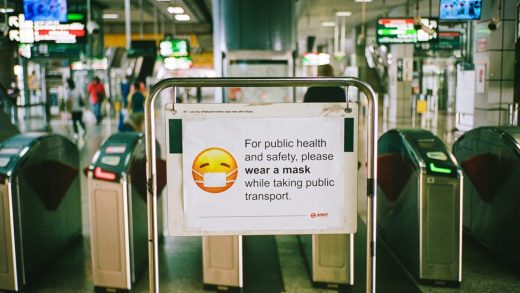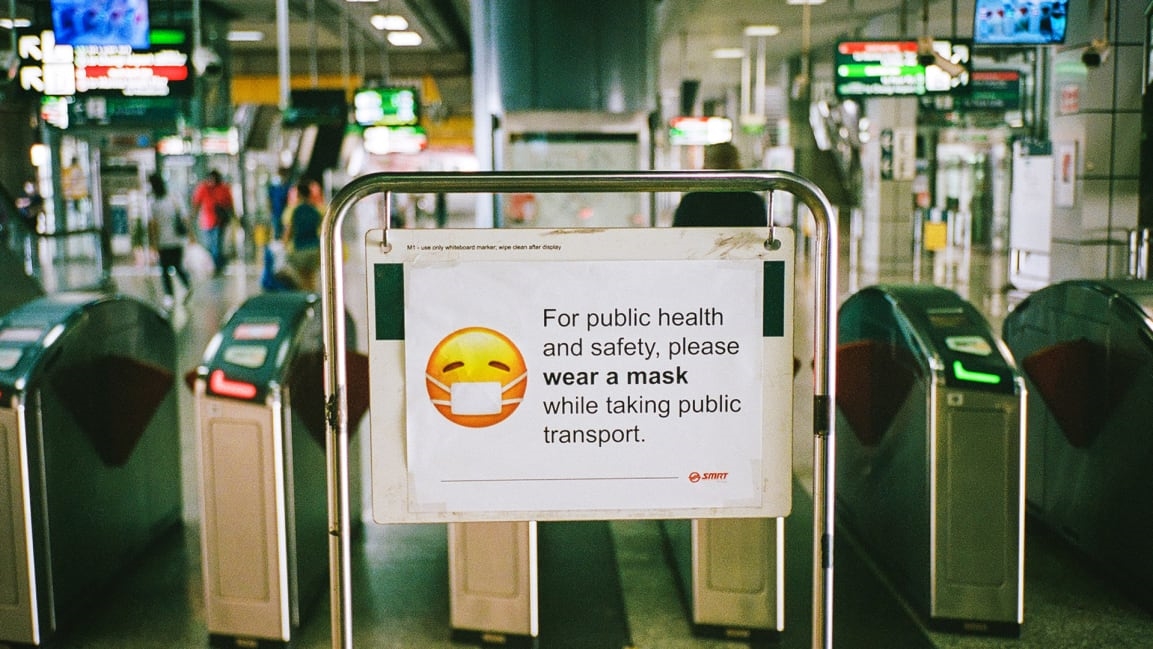How to ask friends, coworkers, and strangers to wear a mask
As coronavirus rates continue to skyrocket across the United States, many of us are following protective measures, such as washing our hands frequently and wearing masks. But despite the evidence that mask wearing and social distancing decrease COVID-19 infection rates, not everyone is doing their part. In a recent Gallup poll, 18% of Americans said they either “rarely” or “never” wear a mask when outside their homes.
So how do you respond when your fellow grocery shopper, coworker, or even your friends and family are sliding back on—or choosing to actively ignore—safety precautions?
According to two experts—Rodolfo Mendoza-Denton and Laurie Weingart, educators specializing in intergroup relations and conflict, respectively—these situations can be fraught and can depend greatly on the situation.
Here are some tips for approaching these nuanced conversations effectively:
How to talk with friends and family
Despite climbing case numbers, many people are understandably missing the social aspect of normal life. Finding ways to connect with others is important to personal well-being, especially in stressful times. But it’s important to know that risk is a spectrum, and some social activities are more dangerous than others. If you’re considering a socially distant meeting, set expectations beforehand with your friends or family.
To start, both experts we spoke to recommend beginning the conversation from a place of respect. “By the time you’ve gotten to the bar or the party with your friend group, it’s probably a little late,” says Mendoza-Denton. “I would advocate for setting the norms and making those norms clear before you engage in the activity. Once you get that initial agreement, you can move forward. And if you can’t reach that agreement, then you have a choice of either excluding [those people] or taking yourself out of the equation.”
Your friends and family may disagree over mask wearing and social distancing because of divergent ideas over individual needs. Weingart, a professor of organizational behavior and theory at Carnegie Mellon’s Tepper School of Business, says excavating these root causes can help people better manage tense situations. She says, “We have this big conflict over wearing a mask, social distancing, when in reality this is a conflict between ‘Do you care about me and my safety?’ versus ‘Do I care about you in terms of your autonomy?’”
These different ideas can create a lack of understanding without proper conversation. “If we don’t surface those things, as well as how we’re going to address both simultaneously, we’re never going to solve the problem of under what circumstances should we wear masks, social distance, et cetera.”
When having difficult conversations, especially with people you’re close with, try your best to catch them at a time when you believe they aren’t on the defensive. “It takes a certain skill to talk with someone with empathy while invoking empathy for them. You have to choose your moments,” says Mendoza-Denton, who is a professor of psychology at the University of California, Berkeley.
“If you are out with a group of friends, it’s better to try to talk with that person at a moment when they are ready and when they are not defensive and there is a feeling of closeness among each other.”
In the case of entering into social gatherings where it can be difficult to control your surroundings, and thus the potential presence of the coronavirus, preparation is the first step. From there, try your best to set expectations of wearing masks and limiting the number of people within a six-feet-distance beforehand. It may be helpful to choose a place where mask mandates and other health protocols are established and enforced. This way, you won’t need to take on the weighty mantle of “rule enforcer.”
If you want to talk openly with your friends, pay attention to your tone. Between expressing yourself and emphasizing and keeping the conversation even-keeled, it’s a complex balancing act. Weingart emphasizes “keeping a lid on the intensity of things, so things don’t escalate—but at the same time be direct in sharing your concerns.”
Keep in mind, if your friends and you have had difficult conversations in the past and survived, this is a similar case where you shouldn’t be scared of talking. In fact, research shows that people frequently mispredict other people’s reactions to open and honest communication.
How to talk with coworkers
As people begin to return to offices, more people will be navigating these tricky conversations with coworkers as well.
With your work colleagues, Weingart suggests focusing initially on the positive, including practicing active listening and empathy and taking into consideration shared goals. If you notice a coworker is not wearing a mask or washing their hands frequently, you shouldn’t jump down the person’s throat immediately—especially since this may result in a defensive response.
Instead, consider that your coworker could be temporarily slipping up and is not intentionally neglecting the rules. Approach your colleague with nonconstraining language—avoid “should” phrases—and give them insight to empathize with you. You might share that you are at risk or live with individuals at risk of contracting the virus.
“You’re not immediately going in and pointing out someone’s mistakes or accusing them of bad behavior. You’re going back [to them] with the understanding they’re just not coming from the same place you are,” says Weingart.
When having these conversations with coworkers, addressing shared goals will give you a mutual jumping-off point. For instance, you can bring up your goal of “staying healthy” or “stopping the spread of the virus” and see if your colleague is on the same page. Ideally, you and your coworker can agree on these basics of overcoming the pandemic.
When finding a setting for these discussions, choose a place out of public view, so it doesn’t feel like one person is ganging up on another, which can escalate a conversation into an argument.
Finally, if all else fails, Mendoza-Denton says deferring to management or other authoritative bodies is always an option—especially if your workplace has already instated clear guidelines. “I don’t advocate being the person on the moral high ground in a situation where there is a clear institutional directive,” he says. “You can bring up your concern once, but then it is better to call management and make sure they enforce it. It’s your right to be protected by the company and let them deal with it.”
To help prevent uncomfortable exchanges among workers, your management should focus on setting safety precedents, by making preparations before the workspace reopens. This means instituting official policies but also modeling norms-based behavior they want to see in their employees. Also, managers shouldn’t forget that many of these health measures are not fully ingrained. Many employees will need reminding.
Says Weingart, “Putting up signs around the office might seem silly and redundant, but I think they’re really helpful to help to remind people that, ‘Oh yeah, I need to wash my hands or use hand sanitizer regularly. I need to keep my mask on.’”
How to talk with strangers in public spaces
With many states reopening on different timelines, public spaces can feel distinctly unsafe. When you’re going to the grocery store, post office, or restaurants, both experts emphasize focusing on situations you can control. If you encounter someone who is failing to abide by health measures, you can politely request that they put on a mask one time. But after that, do not feel pressure to mediate the situation yourself.
It may be time to extricate yourself or hand over enforcement to a manager or authority within the public space. “In order to avoid an argument, the best option may be to disengage and call management, as hard as it may be. It’s management’s responsibility to enforce social distancing rules,” says Mendoza-Denton.
Particularly in instances where you’re interacting with strangers, it can be very difficult to determine how receptive a person would be to speaking politely or opening themselves to another perspective. However, if you feel uncomfortable around the fact they are not wearing a mask or social distancing, the behavior in itself is an indicator. Says Mendoza-Denton, “With strangers in particular, you don’t have the dimension of knowing when they are more ready to listen. But if they’re not wearing a mask or social distancing, it tells you about their likely attitudes.”
If your exchange with a stranger becomes heated, take a moment to review the stakes of the situation: Do I need to be at this restaurant or park? Can I come back tomorrow to pick up this grocery item? When another person escalates an exchange into an argument, a smart response is a calm, nonantagonistic reaction.
“There’s nothing so important we’re doing in a grocery store that we can’t just walk away,” says Weingart. “I think it takes the air out of people when you ignore them, and it gives them oxygen when you react.”
Ultimately, your job is to protect your own health and priorities. While other people may make decisions which go against guidelines or don’t make sense to you, don’t feel pressure to fix things if your own health is in jeopardy. “In the heat of the moment, it can be very difficult to have these conversations,” says Mendoza-Denton. “But it’s important to keep in mind, it’s not your responsibility to expose yourself to vitriol or potential personal harm.”
(97)



